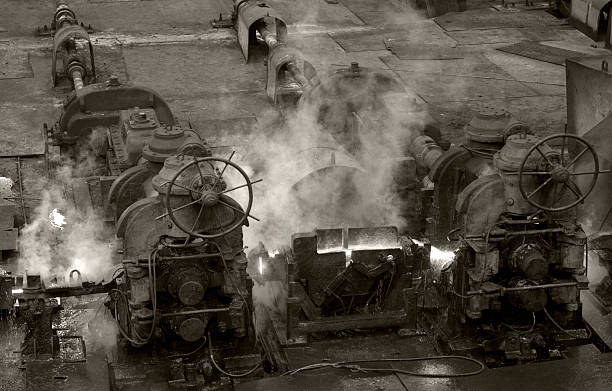The Industrial Revolution (1750–1900) dramatically transformed the global economy, reshaping industries, transportation, and trade networks. This period of rapid technological advancement also had profound effects on silver production and trade, as new mining technologies increased silver output, global demand for silver shifted, and monetary systems evolved. While silver had long been a cornerstone of monetary systems and trade, the Industrial Revolution accelerated its transition from a primary currency metal to an industrial commodity, setting the stage for its modern role in the global economy.

1. Technological Advancements and Increased Silver Production
- New Mining Techniques and Higher Output
- The Industrial Revolution introduced steam-powered drills, dynamite, and improved refining techniques, significantly boosting silver extraction efficiency.
- Cyanide processing (developed in the 1880s) allowed for more efficient silver extraction from low-grade ores, increasing global supply.
- Major Silver Mining Booms
- The Comstock Lode (Nevada, USA, 1859): One of the richest silver discoveries in history, fueling the U.S. economy and global silver trade.
- Mexican Silver Expansion: Mexico remained a leading silver producer, modernizing its mining industry with industrial machinery.
- South American Silver Growth: Peru and Bolivia, long historical silver hubs, saw renewed mining activity due to technological improvements.
- Global Impact of Increased Silver Supply
- The massive increase in silver production drove prices down, making silver less viable as a monetary standard in bimetallic systems.
- Lower silver prices benefited industrial applications, leading to silver’s growing role outside of currency.
2. Shifts in Silver’s Role in Global Trade
- The Decline of Silver as a Monetary Standard
- By the late 19th century, many industrialized nations moved toward the gold standard, reducing silver’s role in monetary systems.
- The U.S. Coinage Act of 1873 (“The Crime of 1873”) effectively demonetized silver, marking a turning point in global finance.
- The Latin Monetary Union (LMU), which had supported bimetallism, struggled to maintain silver’s relevance as gold gained dominance.
- Silver’s Continued Importance in Asia
- While Western economies phased out silver, China, India, and other parts of Asia continued using silver as a primary currency.
- The Industrial Revolution’s expansion of trade networks saw silver flow into Asia in exchange for goods like silk, tea, and porcelain.
- However, as silver prices declined, countries like China faced deflation, causing economic struggles in the late 19th century.
- British and American Trade Shifts
- As industrial economies expanded, gold-backed currencies became preferred for international trade, making silver-backed economies less competitive.
- The British Empire, the world’s dominant industrial power, firmly adopted the gold standard, setting a trend for global trade policies.
3. The Rise of Silver in Industrial Applications
- Photography and Chemical Uses
- The invention of photographic film in the 19th century created a new demand for silver nitrate, making silver essential in the emerging photography industry.
- Silver’s chemical properties made it valuable in industrial and medical applications.
- Electrical and Technological Uses
- As industrialization advanced, silver’s high conductivity made it an important material for early electrical applications.
- The rise of telegraphy and electrical wiring in the late 19th century increased industrial demand for silver.
- Silver’s Shift from Currency to Commodity
- By the early 20th century, silver was increasingly seen as an industrial metal rather than a primary monetary metal.
- This transition set the stage for modern silver markets, where silver is valued both as an investment and for its industrial applications.
Conclusion: Silver’s Changing Role in a New Era
The Industrial Revolution marked a turning point for silver, as technological advancements increased production, while monetary shifts reduced its use as a currency standard. The decline of bimetallism and the rise of the gold standard weakened silver’s role in global finance, but its industrial applications ensured its continued relevance. As the world entered the 20th century, silver would remain an important commodity, playing a crucial role in industries such as photography, electronics, and medicine.
